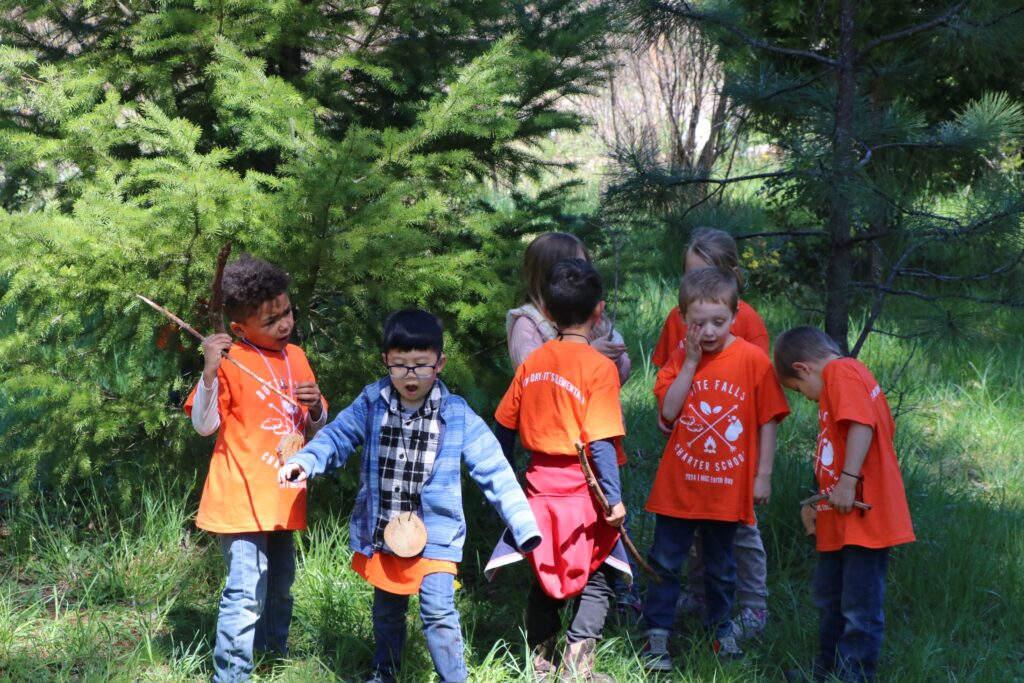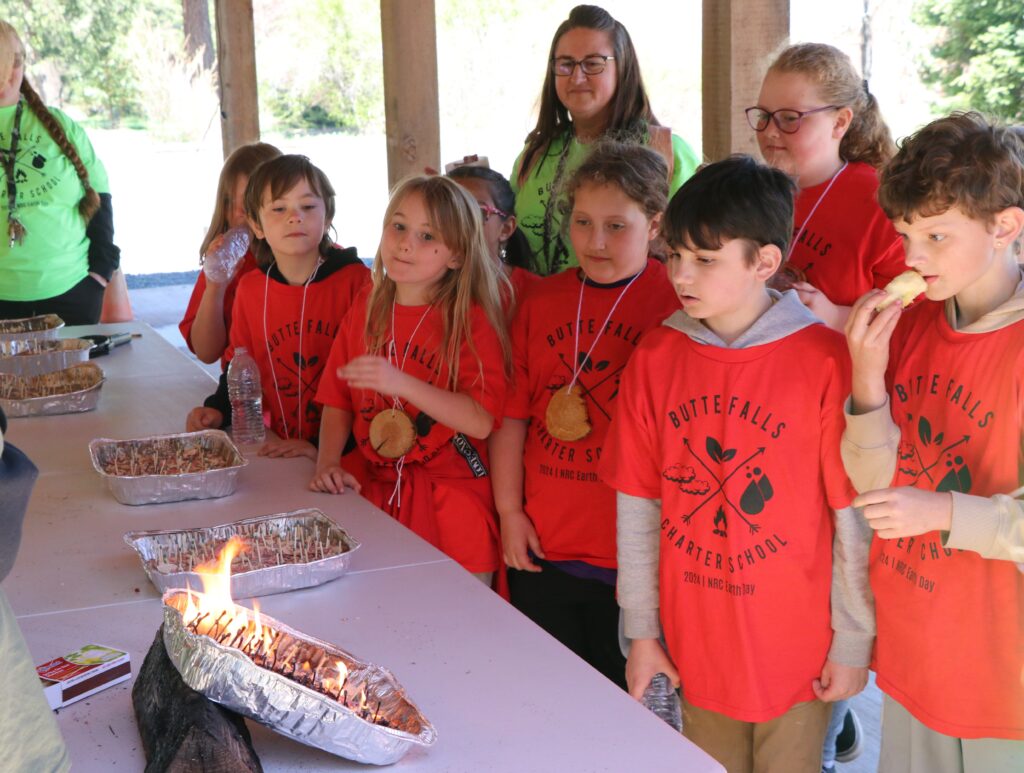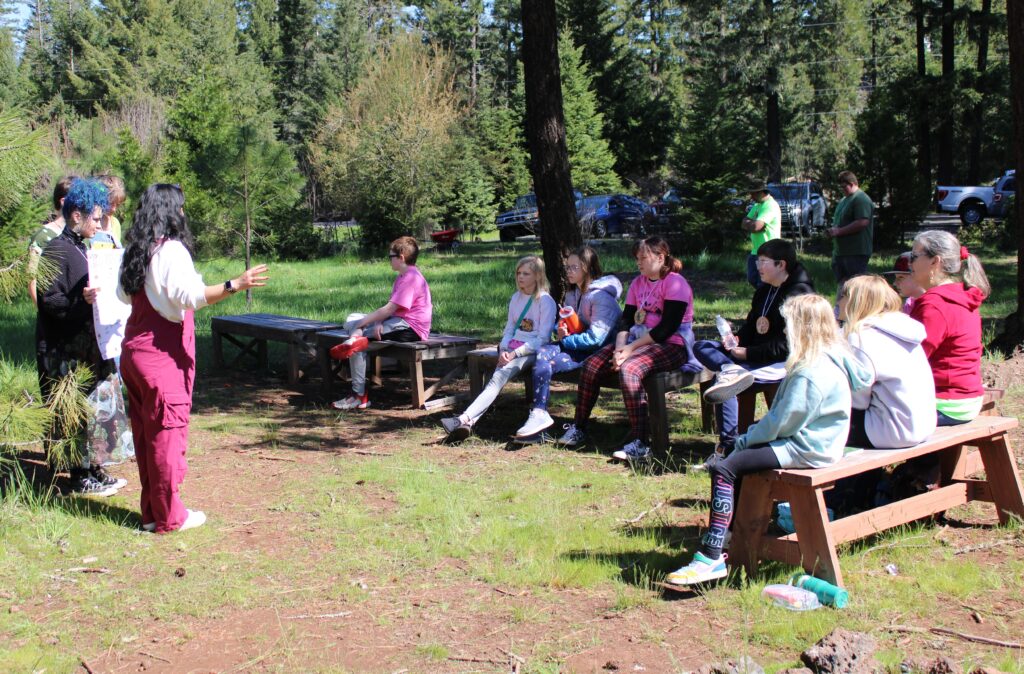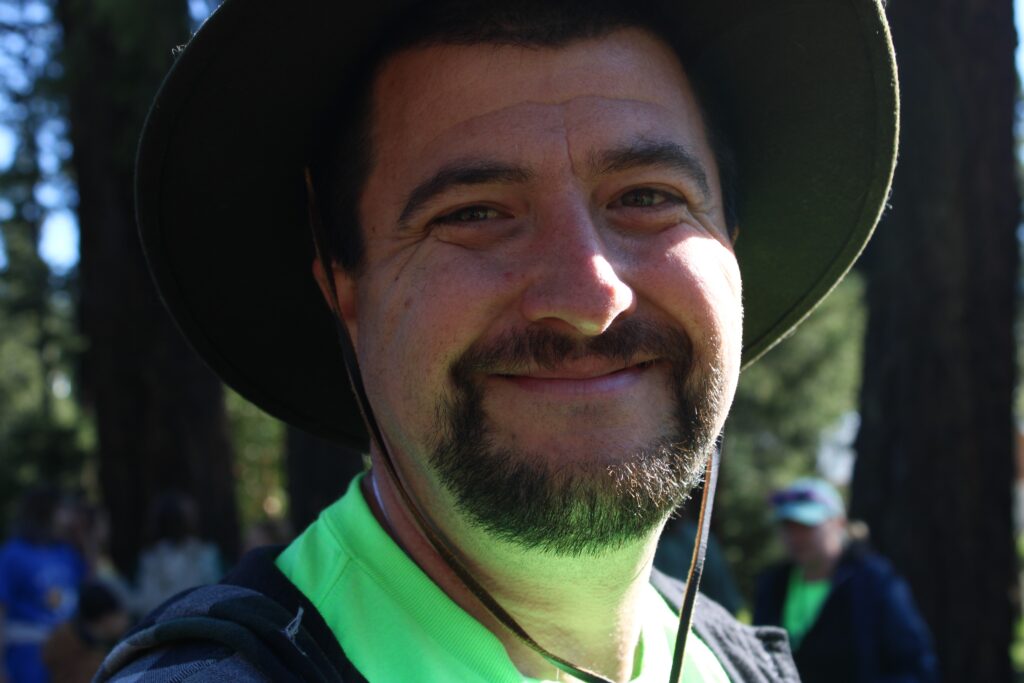
Butte Falls Charter School kindergarten students explore the Butte Falls Natural Resource Center during an Earth Day celebration April 17. The center, a decommissioned state fish hatchery, provides unique learning opportunities for the district’s students. (Photo by Jake Arnold, OSBA)
A tour of the Butte Falls Natural Resource Center alternates between examples of student lessons made real and visions of piles of rubble and cluttered old buildings becoming amazing education opportunities.
The Butte Falls Charter School has turned a decommissioned state fish hatchery into a staff recruiting tool and a student point of pride — a learning facility the likes of which “city schools” don’t have, says freshman Justus Sutfin.
“Taking a liability and making it an asset: That is the challenge in a rural area,” said Superintendent Phil Long.
The remote Butte Falls School District is a single K-12 charter school, and it has its challenges. Butte Falls, off the major roads in the Cascade Range northeast of Medford, has fewer than 500 residents. The K-12 district has fewer than 200 students, with one of Oregon’s highest rates of homeless students. Almost a third of its students have disabilities. Like many districts, Butte Falls is also struggling with falling enrollment.
School Board Chair Katie Misfeldt said the NRC, as locals call it, is one answer for lifting the district.
“It’s what we really have going for us,” she said. “The NRC has so much potential.”
The wooded property, with its mixture of fresh construction and vestiges of a nearly 100-year history, was a hubbub of activity Wednesday, April 17, for an early Earth Day celebration. Students in T-shirts colored according to grade level moved through lessons led by eighth graders and high school students. Students investigated environmental concepts while getting their hands dirty.
That hands-on learning is the NRC’s hallmark, beloved by students.
“Instead of being cooped up in a classroom, we get to go outside and do something that matters,” said freshman Leah Gneiting.

Butte Falls Charter School third graders learn about how fire spreads in different terrain during the April 17 Earth Day celebration at the Butte Falls Natural Resource Center. (Photo by Jake Arnold, OSBA)
When the state closed the hatchery in 2011 because of a persistent fish virus, local construction professional Chris Mathas pressed the school board to obtain the land. Mathas, a longtime school volunteer, became a teacher to continue the district’s career and technical education classes.
Former school board member Steve Nelson, now deceased, and current member Dan Murphy used their own money to travel to Portland to make the final arrangements with the Oregon Department of Fish and Wildlife, Murphy said.
They kept the pressure on the district to use the land wisely.
“You have to have something unique to bring students here,” Murphy said.
The district acquired 10 acres of state land that includes timber, a stream and wetlands. It took until 2018 to make a deal with the federal government for the three acres of adjacent land that hold three 1950s houses, the large facility buildings and other small outbuildings.
As part of the deal, the school had to agree to use the property for education and research in partnership with a university for 30 years. Southern Oregon University graduate students use the land for research projects, sometimes working with Butte Falls students.
Mathas, the site development manager, pursued grants, wheedled partners and cajoled volunteers to make the property suitable for students.
“A lot can be accomplished with less money,” Mathas said. “You just have to be resourceful.”
Mathas said a school board that is “interested, invested and curious” provides the encouragement staff need to do mighty things.
The district has turned the property’s rehabilitation into an endless series of lessons.
The first learning project in 2018 was a Monarch butterfly pollinator garden. Students have built access ramps, fences, a bioswale and new structures that layer in lessons in math, science and trade skills.
“We count on the teachers to create a teachable moment out of the opportunities here,” Mathas said.
A foot bridge project included an 18-month riparian zone study.
Two of the homes have been turned into classroom spaces, with a commercial kitchen that uses produce from the no-till gardens the students started. One of the homes has an apartment to teach life skills to students, especially ones with learning challenges. Another space could become a shelter for homeless students.
The students built a pavilion using lumber they milled on site from fallen trees and salvaged roofing from a gym remodel.
“Our theme has been to use whatever we have around and use it for a good purpose,” said Long. “You feel really good when you build bigger than you are because of things you already had.”
Students have celebrated their prom at the pavilion for three years running. Next to the pavilion is an excavated old retaining pond. The site management plan envisions using it for a stage and amphitheater for events that might draw tourists.
In the mind’s eye of Mathas and Long, buildings still filled with old machinery, lumber and fishery detritus will become career and technical education classrooms, laboratories and community facilities such as a ceramics and arts space. Old concrete slabs are the building blocks of small-group gathering spaces, and brush-choked land awaits clearing for accessible trails.
Science teacher Ben DeCarlow is the education lead and the driving force orchestrating the thriving learning environment. He thrills to students in all grade levels coming regularly to the property a half mile from school for lessons ranging from engineering to nature walk investigations.
“This is why I am working for this district,” DeCarlow said.
Tonya Noon-Toledo, a language arts teacher, also said the NRC is her reason for working for Butte Falls. She uses the property for lessons on topics such as video production, observation practices and writing.
“It is a place that can be as great as our imagination and our ambitions,” she said.
Students visit the property in their free time to do projects or just enjoy a nature break.
Freshman Adrien Mandin said he comes to the property almost every day. He said the NRC helps him stay motivated in school and shows him the district cares about him.
“They are trying to give every kid their own option so they have the best learning opportunity,” he said.
– Jake Arnold, OSBA
[email protected]
During the April 17 Butte Falls Charter School Earth Day celebration, several students were asked to take photos to record the event. Below, Southern Oregon University students teach a lesson on mushrooms to sixth graders. (Photo by Leigh Gneiting, Butte Falls Charter School freshman) Ben DeCarlow, the organizing force behind Butte Falls Natural Resource Center educational uses, allows a portrait during a busy day. (Photo by Constantine Martinez, Butte Falls Charter School junior)

